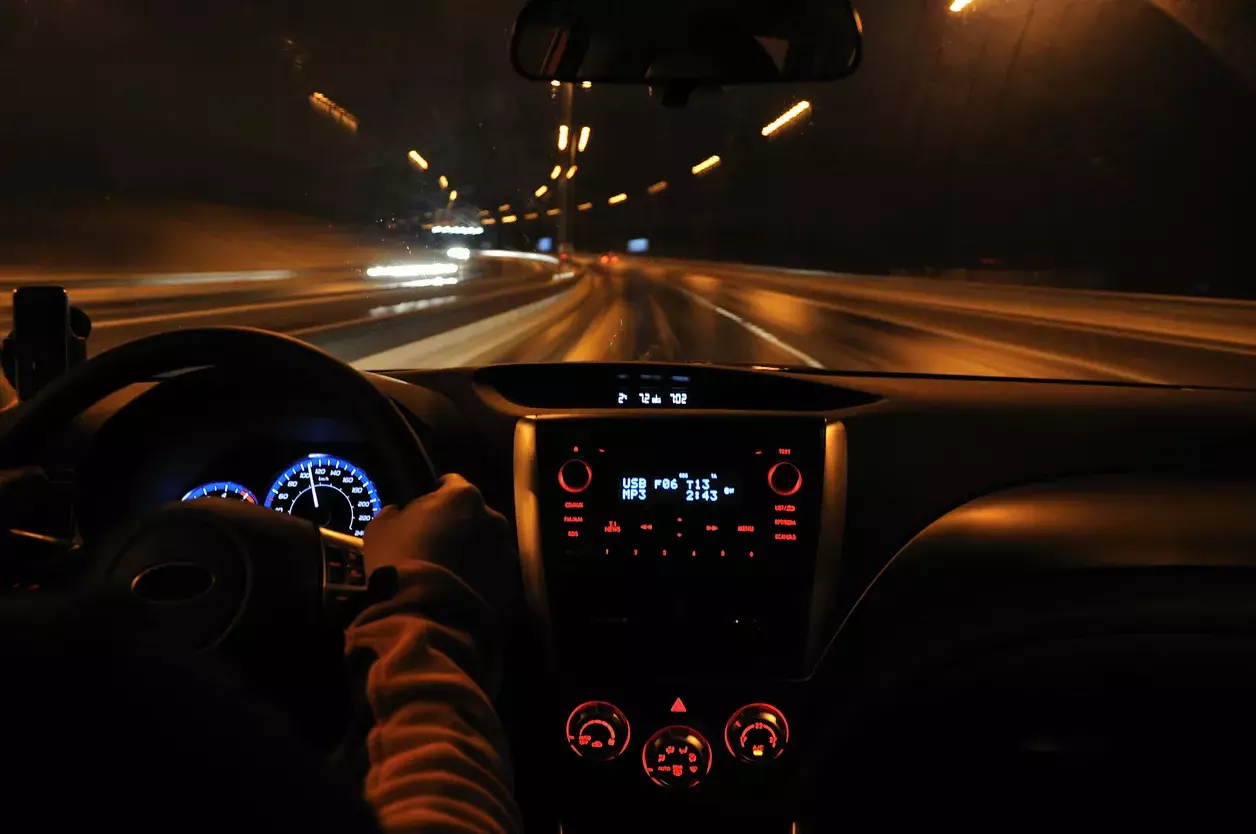Night Driving Safety: Complete Guide for New Drivers
Published on
Night driving presents unique challenges that can be intimidating for new drivers. With reduced visibility, increased fatigue, and different traffic patterns, driving at night requires special skills and awareness. At Rajput Driving School, we recognize that mastering night driving is essential for both safety and passing your G2 and G road tests. This comprehensive guide will teach you everything you need to know about driving safely at night in Ontario.

Why Night Driving is More Dangerous
Understanding the risks of night driving helps you prepare and stay safe:
Key Risk Factors:
- Reduced Visibility: Limited lighting makes it harder to see pedestrians, animals, and road hazards
- Increased Fatigue: Natural circadian rhythms make drivers more tired at night
- Impaired Drivers: Higher likelihood of encountering drunk or impaired drivers
- Wildlife Activity: Animals are more active at dawn and dusk
- Construction Zones: Road work often continues at night with different traffic patterns
Statistics That Matter:
- Fatal crashes are three times more likely at night than during the day
- 50% of traffic deaths occur at night despite 25% less traffic
- Pedestrian fatalities increase by 400% at night
- Fatigue-related crashes peak between 2 AM and 6 AM
Essential Night Driving Preparation
Vehicle Preparation Checklist:
- Clean Headlights: Remove dirt, bugs, and debris from headlight lenses
- Check Bulb Function: Ensure all headlights, taillights, and signal lights work properly
- Clean Windshield: Remove streaks and smudges that can cause glare
- Adjust Mirrors: Properly position all mirrors to minimize blind spots
- Check Tire Pressure: Proper inflation improves handling and fuel efficiency
- Fill Windshield Washer: Ensure you have fluid for cleaning the windshield
Personal Preparation:
- Get Adequate Rest: Ensure you're well-rested before driving at night
- Limit Alcohol: Avoid alcohol entirely when planning to drive
- Check Medications: Review side effects that might affect driving ability
- Bring Emergency Supplies: Keep a flashlight, phone charger, and emergency kit
Headlight Usage and Techniques
Understanding Headlight Types:
- Low Beams: Standard headlights for normal night driving
- High Beams: Brighter lights for rural areas with no oncoming traffic
- Daytime Running Lights: Always-on lights for visibility during daylight
- Fog Lights: Special lights for poor visibility conditions
Proper Headlight Usage:
- Turn On Before Dark: Start using headlights 30 minutes before sunset
- Use High Beams Wisely: Only on rural roads with no oncoming traffic
- Dim for Oncoming Traffic: Switch to low beams when approaching other vehicles
- Follow at Safe Distance: Dim lights when following other vehicles closely
- Use in Bad Weather: Turn on headlights in rain, snow, or fog
Common Headlight Mistakes:
- Driving with high beams in traffic
- Not turning on headlights in twilight conditions
- Using fog lights unnecessarily
- Driving with only one headlight working
Visibility and Scanning Techniques
Enhanced Scanning Strategies:
- Look Beyond Headlights: Scan 12-15 seconds ahead of your vehicle
- Use Peripheral Vision: Watch for movement at the edges of your vision
- Check Side Roads: Look for vehicles entering from side streets
- Watch for Reflections: Look for eye reflections from animals
- Monitor Road Edges: Watch for pedestrians and cyclists
Dealing with Oncoming Headlights:
- Look to the Right: Focus on the right edge of your lane
- Reduce Speed: Slow down when visibility is reduced
- Use Road Markings: Follow painted lines when headlights blind you
- Blink if Necessary: Flash your lights to signal other drivers to dim theirs
Speed and Following Distance
Adjusting Speed for Night Conditions:
- Reduce Speed: Drive slower than the posted speed limit
- Increase Following Distance: Maintain 4-6 seconds behind other vehicles
- Slow for Curves: Reduce speed before entering curves
- Brake Earlier: Begin braking sooner than during daylight
Safe Following Techniques:
- Use the 4-second rule in good conditions
- Increase to 6-8 seconds in poor visibility
- Watch the vehicle two cars ahead when possible
- Avoid tailgating, especially trucks and buses
Handling Different Night Driving Scenarios
Urban Night Driving:
- Watch for Pedestrians: Look for people crossing streets
- Be Alert at Intersections: Check for vehicles running red lights
- Use Turn Signals Early: Give other drivers more time to react
- Watch for Emergency Vehicles: Be prepared to yield to ambulances and police
Highway Night Driving:
- Use High Beams When Safe: Improve visibility on open highways
- Watch for Construction: Be alert for lane changes and barriers
- Monitor Truck Traffic: Give large vehicles extra space
- Plan Lane Changes: Signal early and check mirrors thoroughly
Rural Night Driving:
- Watch for Wildlife: Be especially alert for deer and other animals
- Use High Beams: Take advantage of better visibility
- Slow for Unmarked Intersections: Approach with extra caution
- Watch for Farm Equipment: Be alert for slow-moving vehicles
Dealing with Fatigue and Drowsiness
Recognizing Signs of Fatigue:
- Difficulty keeping eyes open
- Yawning frequently
- Drifting between lanes
- Missing exits or traffic signs
- Feeling restless or irritable
Preventing Driver Fatigue:
- Get 7-8 Hours Sleep: Ensure adequate rest before driving
- Take Regular Breaks: Stop every 2 hours or 200 kilometers
- Share Driving Duties: Rotate drivers on long trips
- Avoid Driving During Peak Fatigue Times: 2 AM to 6 AM are highest risk
- Stay Hydrated: Drink water regularly but avoid excessive caffeine
What to Do If You Feel Tired:
- Pull Over Immediately: Find a safe place to stop
- Take a Short Nap: 20-30 minutes can help significantly
- Get Fresh Air: Step outside and walk around
- Find Alternative Transportation: Consider calling a taxi or rideshare
- Never Drive Impaired: Don't drive when you're too tired
Weather Considerations for Night Driving
Rain and Wet Conditions:
- Reduce Speed: Drive slower on wet roads
- Increase Following Distance: Allow more space for braking
- Use Headlights: Turn on lights in rain, even during daylight
- Avoid Hydroplaning: Don't drive through standing water
Fog and Low Visibility:
- Use Low Beams: High beams reflect off fog and reduce visibility
- Use Fog Lights: If your vehicle has them, turn them on
- Slow Down Significantly: Reduce speed to match visibility
- Follow Road Markings: Use lane lines to stay in your lane
Snow and Ice:
- Clear All Windows: Remove all snow and ice before driving
- Use Winter Tires: Ensure proper traction for winter conditions
- Drive Very Slowly: Reduce speed significantly on icy roads
- Increase Following Distance: Allow much more space for stopping
Night Driving Skills for Future Reference
While G2 and G road tests are conducted during daylight hours, developing strong night driving skills is essential for real-world driving. These skills will serve you well once you have your full license and need to drive at night.
Key Night Driving Skills to Develop:
- Proper Headlight Usage: Knowing when and how to use different headlight settings
- Speed Management: Adjusting speed based on visibility conditions
- Enhanced Observation: Scanning effectively in low-light conditions
- Safe Following Distance: Maintaining appropriate gaps behind other vehicles
- Signal Usage: Using turn signals early and appropriately for better visibility
Common Night Driving Mistakes to Avoid:
- Not turning on headlights when required
- Driving too fast for visibility conditions
- Following other vehicles too closely
- Not scanning effectively for hazards
- Using high beams inappropriately
Advanced Night Driving Techniques
Using Technology to Your Advantage:
- GPS Navigation: Use GPS to reduce cognitive load and stress
- Adaptive Headlights: Take advantage of modern headlight systems
- Blind Spot Monitoring: Use technology to supplement your observations
- Collision Warning Systems: Let technology help detect hazards
Building Night Driving Confidence:
- Start with Familiar Routes: Practice on roads you know well
- Begin with Short Trips: Gradually increase night driving distance
- Practice in Different Conditions: Experience various weather and traffic situations
- Drive with Experienced Passengers: Have someone help guide you initially
Emergency Situations at Night
Vehicle Breakdown:
- Pull Off Safely: Get completely off the roadway
- Turn on Hazard Lights: Make your vehicle visible
- Stay with Your Vehicle: Remain inside with doors locked
- Call for Help: Use your phone to contact roadside assistance
Encountering Wildlife:
- Don't Swerve: Brake firmly but avoid swerving into other lanes
- Honk Your Horn: Try to scare animals away
- Watch for More Animals: Deer often travel in groups
- Report Large Animals: Contact local authorities about injured animals
Conclusion: Master Night Driving for Safety and Success
Night driving is a skill that improves with practice and proper preparation. By understanding the unique challenges of driving at night and implementing the safety techniques outlined in this guide, you'll become a confident and safe night driver. Remember, the key to successful night driving is preparation, awareness, and patience.
At Rajput Driving School, we include night driving practice in our comprehensive driver education programs. Our experienced instructors will help you build the skills and confidence needed to drive safely at night, whether you're preparing for your G2 or G road test or simply want to become a safer driver.
Don't let night driving anxiety hold you back. With proper training and practice, you can master this essential driving skill and stay safe on Ontario's roads, day or night.
Book Night Driving LessonsCategories
Recent Posts
- New Driver Insurance Guide: Save Money on Car Insurance in Ontario
- Complete Roundabout Navigation Guide: Master Traffic Circles Safely
- Emergency Driving Situations: What to Do When Things Go Wrong
- What Happens If You Fail The G1 Test?
- Step-by-Step Guide to Getting Your G1, G2, and G Driver's Licence
- The G2 Road Test Examination Sheet Explained
- The G2 Road Test: How to Pass on Your First Try
- 10 Defensive Driving Tips That Can Save Your Life
- Failed the Ontario G Road Test? Here's What Happens Next
- Top 10 Reasons for Failing the G Road Test in Windsor, Ontario
- Winter Driving Safety: 10 Essential Tips
- 10 Reasons Why You Should Take Driver's Ed in Windsor, Ontario
- How to Parallel Park in 3 Easy Steps
- Top 5 Tips for Passing Your Driving Test in Windsor
- The Benefits of Taking Driving Lessons
- Understanding Ontario's Graduated Licensing System
